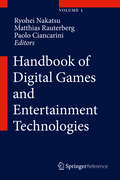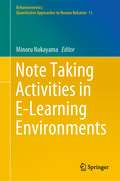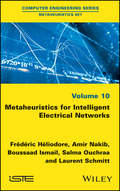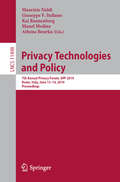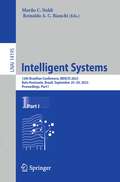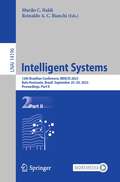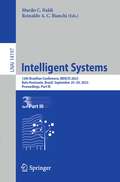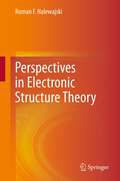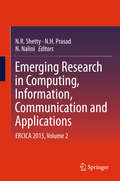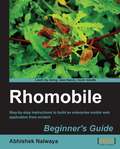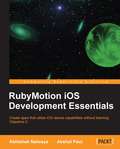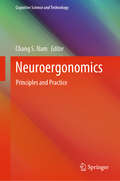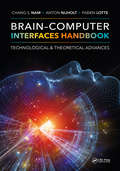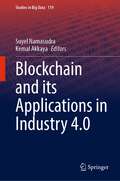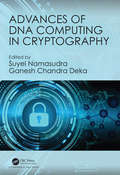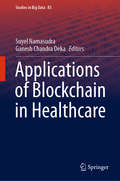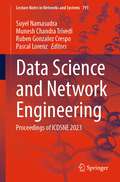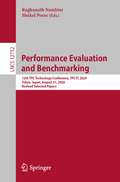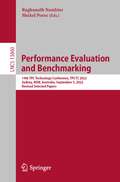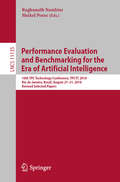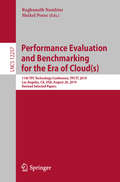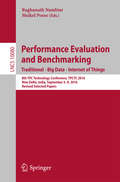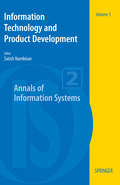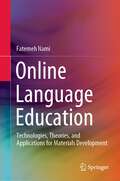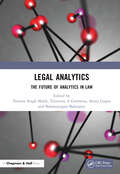- Table View
- List View
Handbook of Digital Games and Entertainment Technologies
by Ryohei Nakatsu Matthias Rauterberg Paolo CiancariniThe topics treated in this handbook cover all areas of games and entertainment technologies, such as digital entertainment; technology, design/art, and sociology. The handbook consists of contributions from top class scholars and researchers from the interdisciplinary topic areas. The aim of this handbook is to serving as a key reference work in the field and provides readers with a holistic picture of this interdisciplinary field covering technical issues, aesthetic/design issues, and sociological issues. At present, there is no reference work in the field that provides such a broad and complete picture of the field. Engineers and researchers who want to learn about this emerging area will be able to find adequate answers regarding technology issues on digital entertainment. Designers and artists can learn how their skills and expertise can contribute to this emerging area. Also researchers working in the field of sociology and psychology will find how their experience and knowledge are connected to other areas such as technology and art/design. Although topics are written by foremost experts from the field, the description for each topic has been intended to be easily understandable but yet comprehensive enough so that it caters not only for the experts but also beginners and students in the field.
Note Taking Activities in E-Learning Environments (Behaviormetrics: Quantitative Approaches to Human Behavior #11)
by Minoru NakayamaThe main focus of this book is presenting practical procedures for improving learning effectiveness using note taking activities during e-learning courses. Although presentation of e-learning activities recently has been spreading to various education sectors, some practical problems have been discussed such as evaluation of learning performance and encouragement of students. The authors introduce note taking activity as a conventional learning tool in order to promote individual learning activity and learning efficacy. The effectiveness of note taking has been measured in practical teaching in a Japanese university using techniques of learning analytics, and the results are shown here. The relationships between note taking activity and students’ characteristics, the possibility of predicting the final learning performance using metrics of students’ note taking, and the effectiveness for individual emotional learning factors are evaluated. Some differences between blended learning and fully online learning courses are also discussed. The authors provide novel analytical procedures and ideas to manage e-learning courses. In particular, the assessment of note taking activity may help to track individual learning progress and to encourage learning motivation.
Metaheuristics for Intelligent Electrical Networks
by Amir Nakib Boussaad Ismail Frédéric Héliodore Laurent Schmitt Salma OuchraaThe optimization tools are ubiquitous in modeling and the use of electrical networks. Managing the complexity of these electrical networks leads to analyze and define new methodologies, able to combine performance and near-operational processing. Metaheuristics offer a range of solutions as efficient as they are innovative.
Privacy Technologies and Policy: 7th Annual Privacy Forum, APF 2019, Rome, Italy, June 13–14, 2019, Proceedings (Lecture Notes in Computer Science #11498)
by Maurizio Naldi Giuseppe F. Italiano Kai Rannenberg Manel Medina Athena BourkaThis book constitutes the refereed conference proceedings of the 7th Annual Privacy Forum, APF 2019, held in Rome,Italy, in June 2019. The 11 revised full papers were carefully reviewed and selected from 49 submissions. The papers present original work on the themes of data protection and privacy and their repercussions on technology, business, government, law, society, policy and law enforcement bridging the gap between research, business models, and policy. They are organized in topical sections on transparency, users' rights, risk assessment, and applications.
Intelligent Systems: 12th Brazilian Conference, BRACIS 2023, Belo Horizonte, Brazil, September 25–29, 2023, Proceedings, Part I (Lecture Notes in Computer Science #14195)
by Murilo C. Naldi Reinaldo A. C. BianchiThe three-volume set LNAI 14195, 14196, and 14197 constitutes the refereed proceedings of the 12th Brazilian Conference on Intelligent Systems, BRACIS 2023, which took place in Belo Horizonte, Brazil, in September 2023. The 90 full papers included in the proceedings were carefully reviewed and selected from 242 submissions. They have been organized in topical sections as follows:Part I: Best papers; resource allocation and planning; rules and feature extraction; AI and education; agent systems; explainability; AI models; Part II: Transformer applications; convolutional neural networks; deep learning applications; reinforcement learning and GAN; classification; machine learning analysis;Part III: Evolutionary algorithms; optimization strategies; computer vision; language and models; graph neural networks; pattern recognition; AI applications.
Intelligent Systems: 12th Brazilian Conference, BRACIS 2023, Belo Horizonte, Brazil, September 25–29, 2023, Proceedings, Part II (Lecture Notes in Computer Science #14196)
by Murilo C. Naldi Reinaldo A. C. BianchiThe three-volume set LNAI 14195, 14196, and 14197 constitutes the refereed proceedings of the 12th Brazilian Conference on Intelligent Systems, BRACIS 2023, which took place in Belo Horizonte, Brazil, in September 2023. The 90 full papers included in the proceedings were carefully reviewed and selected from 242 submissions. They have been organized in topical sections as follows:Part I: Best papers; resource allocation and planning; rules and feature extraction; AI and education; agent systems; explainability; AI models; Part II: Transformer applications; convolutional neural networks; deep learning applications; reinforcement learning and GAN; classification; machine learning analysis;Part III: Evolutionary algorithms; optimization strategies; computer vision; language and models; graph neural networks; pattern recognition; AI applications.
Intelligent Systems: 12th Brazilian Conference, BRACIS 2023, Belo Horizonte, Brazil, September 25–29, 2023, Proceedings, Part III (Lecture Notes in Computer Science #14197)
by Murilo C. Naldi Reinaldo A. C. BianchiThe three-volume set LNAI 14195, 14196, and 14197 constitutes the refereed proceedings of the 12th Brazilian Conference on Intelligent Systems, BRACIS 2023, which took place in Belo Horizonte, Brazil, in September 2023. The 90 full papers included in the proceedings were carefully reviewed and selected from 242 submissions. They have been organized in topical sections as follows:Part I: Best papers; resource allocation and planning; rules and feature extraction; AI and education; agent systems; explainability; AI models; Part II: Transformer applications; convolutional neural networks; deep learning applications; reinforcement learning and GAN; classification; machine learning analysis;Part III: Evolutionary algorithms; optimization strategies; computer vision; language and models; graph neural networks; pattern recognition; AI applications.
Perspectives in Electronic Structure Theory
by Roman F. NalewajskiThe understanding in science implies insights from several different points of view. Alternative modern outlooks on electronic structure of atoms and molecules, all rooted in quantum mechanics, are presented in a single text. Together these complementary perspectives provide a deeper understanding of the localization of electrons and bonds, the origins of chemical interaction and reactivity behavior, the interaction between the geometric and electronic structure of molecules, etc. In the opening two parts the basic principles and techniques of the contemporary computational and conceptual quantum chemistry are presented, within both the wave-function and electron-density theories. This background material is followed by a discussion of chemical concepts, including stages of the bond-formation processes, chemical valence and bond-multiplicity indices, the hardness/softness descriptors of molecules and reactants, and general chemical reactivity/stability principles. The insights from Information Theory, the basic elements of which are briefly introduced, including the entropic origins and Orbital Communication Theory of the chemical bond, are the subject of Part IV. The importance of the non-additive (interference) information tools in exploring patterns of chemical bonds and their covalent and ionic components will be emphasized.
Emerging Research in Computing, Information, Communication and Applications
by N. Nalini N. H. Prasad N. R. ShettyThis proceedings volume covers the proceedings of ERCICA 2015. ERCICA provides an interdisciplinary forum for researchers, professional engineers and scientists, educators, and technologists to discuss, debate and promote research and technology in the upcoming areas of Computing, Information, Communication and their Applications. The contents of this book cover emerging research areas in fields of Computing, Information, Communication and Applications. This will prove useful to both researchers and practicing engineers.
Rhomobile Beginner's Guide
by Abhishek NalwayaPart of Packt's Beginner's Guide series, this book is packed full of practical examples and screenshots to make building your application straightforward and fun.Whether you have prior experience of developing mobile applications or this is your first venture, all newcomers to Rhomobile will be able to quickly develop their own mobile application. This book is accessible for people who are completely new to Ruby, though having prior knowledge of it would be a huge advantage.
RubyMotion iOS Develoment Essentials
by Abhishek Nalwaya Akshat PaulThis is a step-by-step book that builds on your knowledge by adding to an example app over the course of each chapter. Each topic uses example code that can be compiled and tested to show how things work practically instead of just telling you the theory. Complicated tasks are broken down into easy to follow steps with clear explanations of what each line of code is doing.Whether you are a novice to iOS development or looking for a simpler alternative to Objective-C; with RubyMotion iOS Development Essentials, you will become a pro at writing great iOS apps
Neuroergonomics: Principles and Practice (Cognitive Science and Technology)
by Chang S. NamThis book sums up key research findings, and theoretical and technological advances having a direct bearing on neuroergonomics. Neuroergonomics is an emerging area whose Neuroergonomics is an emerging area that is collectively defined as the study of human brain function and behaviour in relation to behavioural performance in natural environments and everyday settings. It helps readers to understand neural mechanisms of human cognition in the context of human interaction with complex systems, as well as understanding the change of perception, decision-making and training in humans. The authors give new insights into augmenting human performance, reflecting upon the opportunities provided through neuroergonomics research and development. Computer systems acting on data from behavioural-output, physiological, and neurological sensing technologies are used to determine the user’s cognitive state and adapt the systems to change, support, and monitor human cognition. Various domains and case studies delve into the field of neuroergonomics in detail. These include, but are not limited to:an evaluation of technologies in health, workplace, and education settings, to show the different impacts of neuroergonomics in everyday lives;assessment of real-time cognitive measures;dynamic casual interactions between inhibition and updating functions, through analysis of behavioral, neurophysiological and effective connectivity metrics; and applications in human performance modelling and assessment of mental workload, showing the reader how to train and improve working memory capacity.Neuroergonomics: Principles and Practice provides academic practitioners and graduate students with a single go-to handbook that will be of significant assistance in research associated with human factors and ergonomics, human-computer interaction, human-systems engineering and cognitive neuroscience.
Brain–Computer Interfaces Handbook: Technological and Theoretical Advances
by Chang S. Nam Anton Nijholt Fabien LotteBrain–Computer Interfaces Handbook: Technological and Theoretical Advances provides a tutorial and an overview of the rich and multi-faceted world of Brain–Computer Interfaces (BCIs). The authors supply readers with a contemporary presentation of fundamentals, theories, and diverse applications of BCI, creating a valuable resource for anyone involved with the improvement of people’s lives by replacing, restoring, improving, supplementing or enhancing natural output from the central nervous system. It is a useful guide for readers interested in understanding how neural bases for cognitive and sensory functions, such as seeing, hearing, and remembering, relate to real-world technologies. More precisely, this handbook details clinical, therapeutic and human-computer interfaces applications of BCI and various aspects of human cognition and behavior such as perception, affect, and action. It overviews the different methods and techniques used in acquiring and pre-processing brain signals, extracting features, and classifying users’ mental states and intentions. Various theories, models, and empirical findings regarding the ways in which the human brain interfaces with external systems and environments using BCI are also explored. The handbook concludes by engaging ethical considerations, open questions, and challenges that continue to face brain–computer interface research. Features an in-depth look at the different methods and techniques used in acquiring and pre-processing brain signals, extracting features, and classifying the user's intention Covers various theories, models, and empirical findings regarding ways in which the human brain can interface with the systems or external environments Presents applications of BCI technology to understand various aspects of human cognition and behavior such as perception, affect, action, and more Includes clinical trials and individual case studies of the experimental therapeutic applications of BCI Provides human factors and human-computer interface concerns in the design, development, and evaluation of BCIs Overall, this handbook provides a synopsis of key technological and theoretical advances that are directly applicable to brain–computer interfacing technologies and can be readily understood and applied by individuals with no formal training in BCI research and development.
Blockchain and its Applications in Industry 4.0 (Studies in Big Data #119)
by Suyel Namasudra Kemal AkkayaThis book discusses fundamentals of Blockchain technology and Industry 4.0. It discusses many applications of Blockchain technology in Industry 4.0, including integration of AI, IoT, and big data with Blockchain for Industry 4.0. It provides cutting-edge research content from researchers, academicians, and other professionals from different background areas to show their state-of-the-art knowledge to use Blockchain in Industry 4.0. The book discusses advantages of Industry 4.0, such as improved productivity, improved efficiency, flexibility, agility, better user experience, and many more, and also entails some challenges too, such as trust, traceability, security, reliability, transparency, etc., for creating an application of Industry 4.0. The book helps graduate, postgraduate, doctoral students, and industrial professionals to implement Blockchain in Industry 4.0.
Advances of DNA Computing in Cryptography
by Suyel Namasudra Ganesh Chandra DekaThis book discusses the current technologies of cryptography using DNA computing. Various chapters of the book will discuss the basic concepts of cryptography, steganography, basic concepts of DNA and DNA computing, approaches of DNA computing in cryptography, security attacks, practical implementaion of DNA computing, applications of DNA computing in the cloud computing environment, applications of DNA computing for big data, etc. It provides a judicious mix of concepts, solved examples and real life case studies.
Applications of Blockchain in Healthcare (Studies in Big Data #83)
by Suyel Namasudra Ganesh Chandra DekaThis book discusses applications of blockchain in healthcare sector. The security of confidential and sensitive data is of utmost importance in healthcare industry. The introduction of blockchain methods in an effective manner will bring secure transactions in a peer-to-peer network. The book also covers gaps of the current available books/literature available for use cases of Distributed Ledger Technology (DLT) in healthcare. The information and applications discussed in the book are immensely helpful for researchers, database professionals, and practitioners. The book also discusses protocols, standards, and government regulations which are very useful for policymakers.
Data Science and Network Engineering: Proceedings of ICDSNE 2023 (Lecture Notes in Networks and Systems #791)
by Suyel Namasudra Munesh Chandra Trivedi Ruben Gonzalez Crespo Pascal LorenzThis book includes research papers presented at the International Conference on Data Science and Network Engineering (ICDSNE 2023) organized by the Department of Computer Science and Engineering, National Institute of Technology Agartala, Tripura, India, during July 21–22, 2023. It includes research works from researchers, academicians, business executives, and industry professionals for solving real-life problems by using the advancements and applications of data science and network engineering. This book covers many advanced topics, such as artificial intelligence (AI), machine learning (ML), deep learning (DL), computer networks, blockchain, security and privacy, Internet of things (IoT), cloud computing, big data, supply chain management, and many more. Different sections of this book are highly beneficial for the researchers, who are working in the field of data science and network engineering.
Performance Evaluation and Benchmarking: 12th TPC Technology Conference, TPCTC 2020, Tokyo, Japan, August 31, 2020, Revised Selected Papers (Lecture Notes in Computer Science #12752)
by Raghunath Nambiar Meikel PoessThis book constitutes the refereed post-conference proceedings of the 12th TPC Technology Conference on Performance Evaluation and Benchmarking, TPCTC 2020, held in August 2020.The 8 papers presented were carefully reviewed and cover the following topics: testing ACID compliance in the LDBC social network benchmark; experimental performance evaluation of stream processing engines made easy; revisiting issues in benchmarking metric selection; performance evaluation for digital transformation; experimental comparison of relational and NoSQL document systems; a framework for supporting repetition and evaluation in the process of cloud-based DBMS performance benchmarking; benchmarking AI inference; a domain independent benchmark evolution model for the transaction processing performance council.
Performance Evaluation and Benchmarking: 14th TPC Technology Conference, TPCTC 2022, Sydney, NSW, Australia, September 5, 2022, Revised Selected Papers (Lecture Notes in Computer Science #13860)
by Raghunath Nambiar Meikel PoessThis book constitutes the refereed post-conference proceedings the 14th TPC Technology Conference on Performance Evaluation and Benchmarking, TPCTC 2022, which was held in Sydney, NSW, Australia, on September 5, 2022.The 5 revised full papers presented were carefully selected from 12 submissions. The conference focuses on Pick and Mix Isolation Levels; Benchmarking considerations for Trustworthy and Responsible AI (Panel); Preliminary Scaling Characterization with TPCx-AI and New Initiatives.
Performance Evaluation and Benchmarking for the Era of Artificial Intelligence: 10th TPC Technology Conference, TPCTC 2018, Rio de Janeiro, Brazil, August 27–31, 2018, Revised Selected Papers (Lecture Notes in Computer Science #11135)
by Raghunath Nambiar Meikel PoessThis book constitutes the thoroughly refereed post-conference proceedings of the 10th TPC Technology Conference on Performance Evaluation and Benchmarking, TPCTC 2018, held in conjunction with the 44th International Conference on Very Large Databases (VLDB 2018) in August 2018.The 10 papers presented were carefully reviewed and selected from numerous submissions.The TPC encourages researchers and industry experts to present and debate novel ideas and methodologies in performance evaluation, measurement, and characterization.
Performance Evaluation and Benchmarking for the Era of Cloud: 11th TPC Technology Conference, TPCTC 2019, Los Angeles, CA, USA, August 26, 2019, Revised Selected Papers (Lecture Notes in Computer Science #12257)
by Raghunath Nambiar Meikel PoessThis book constitutes the refereed post-conference proceedings of the 11th TPC Technology Conference on Performance Evaluation and Benchmarking, TPCTC 2019, held in conjunction with the 45th International Conference on Very Large Databases (VLDB 2019) in August 2019.The 11 papers presented were carefully reviewed and focus on topics such as blockchain; big data and analytics; complex event processing; database Optimizations; data Integration; disaster tolerance and recovery; artificial Intelligence; emerging storage technologies (NVMe, 3D XPoint Memory etc.); hybrid workloads; energy and space efficiency; in-memory databases; internet of things; virtualization; enhancements to TPC workloads; lessons learned in practice using TPC workloads; collection and interpretation of performance data in public cloud environments.
Performance Evaluation and Benchmarking. Traditional - Big Data - Internet of Things
by Raghunath Nambiar Meikel PoessThis book constitutes the thoroughly refereed post-conference proceedings of the 8th TPC Technology Conference, on Performance Evaluation and Benchmarking, TPCTC 2016, held in conjunction with the 41st International Conference on Very Large Databases (VLDB 2016) in New Delhi, India, in September 2016. The 9 papers presented were carefully reviewed and selected from 20 submissions. They reflect the rapid pace at which industry experts and researchers develop innovative techniques for evaluation, measurement and characterization of complex systems.
Information Technology and Product Development
by Satish NambisanInformation Technology and Product Development: A Research Agenda presents important new research from varied disciplines aimed at developing new theoretical concepts and insights on the application of IT in product and service innovation. Drawing on the work of researchers in such varied management areas as information services, technology management, marketing, operations, business strategy and organizational behavior, the book redefines the role of IT in product and service development and the organizational and management issues underlying the successful deployment of IT in innovation contexts, and provides a foundation for future research on the diverse types of IT applications in product development and their potential impact on both product and service innovation. Reflecting two critical shifts in the service sector - the increased complexity and convergence in products and services, along with the rise of the Internet and rapid digitization of products and services - the book is organized into three sections. Section 1 presents four chapters that focus on the traditional areas of project and process management; Section 2 presents four chapters focusing on the emerging areas of collaborative innovation and knowledge co-creation; and Section 3 presents one chapter that draws it all together and identifies some of the important themes and issues for future research. This important new work has much to offer academic researchers in management in its in-depth theoretical analysis of the wide range of organizational and management issues associated with the application of IT in product and service development. It will also appeal to researchers and thought-leaders in consulting organizations whose primary area of interest is product development or IT applications.
Online Language Education: Technologies, Theories, and Applications for Materials Development
by Fatemeh NamiThis book addresses the gap between Computer-Assisted Language Learning (CALL) materials development and its theoretical considerations by offering a comprehensive look into theory, practice, and research on materials development and content authoring for language instruction/practice, drawing on the author’s personal experiences along with previous empirical/theoretical research in CALL materials development, content authoring, language teacher education, and e-learning. The book features four sections. In addition to highlighting related theoretical underpinnings, key concepts, linguistic-didactic functionalities and interaction scenarios in materials development, the volume will address the practical issues and considerations not only in the design, development, integration, and evaluation of the technology-enhanced materials development for language instruction but also the protection, usability, and access in authored and/or co-authored content. Furthermore, previous research findings and foci are addressed to highlight the research gaps and pedagogical implications for materials developers, policy makers, and language teachers. The book can help teachers, educators, and researchers overcome the aforementioned problem by providing a step-by-step guideline on how to effectively integrate technology and design and develop instructional materials for online language instruction and practice.
Legal Analytics: The Future of Analytics in Law
by Namita Singh Malik, Elizaveta A Gromova, Smita Gupta and Balamurugan BalusamyLegal Analytics: The Future of Analytics in Law navigates the crisscrossing of intelligent technology and legal field in building up new landscape of transformation. Legal automation navigation is multidimensional wherein it intends to construct streamline communication, approval and management of legal task. Evolving environment of technology has emphasized need for better automations in legal field from time to time. Although legal scholars took long to embrace Information revolution of legal field. •Describes the historical development of law and automation •Analyses the challenges and opportunities in law and automation •Studies the current research and development in the convergence of Law, Artificial Intelligence and Legal Analytics •Explores the recent emerging trends and technologies that are used by various legal System globally for Crime Prediction & Prevention •Examines the applicability of legal analytics in forensic investigation •Investigates the impact of legal analytics tools and techniques in judicial decision making •Analyses deep learning techniques and its scope in accelerating legal analytics in developed and developing countries • Provides the in-depth analysis of implementation, challenges and issues in the society related to legal analytics The book is primarily aimed at graduates, postgraduates in law & technology, computer science and information technology. Legal practitioners and academicians will also find this book helpful.
